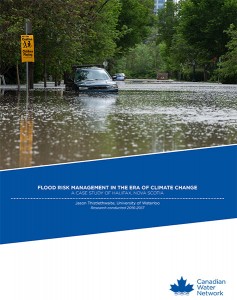Using a Coupled Hydrologic-Insurance Model to Examine Flood Policy Responses in an Era of Climate Change
Jason Thistlethwaite, Assistant Professor, University of Waterloo (2016-2017)

Challenge
Changes in the intensity and frequency of storms and precipitation events are expected to aggravate flooding in municipalities across Canada. Adaptation challenges to reduce flood risk associated with climate change are primarily social, political, and economic. There is a growing concern that changes in hazard severity and frequency under climate change will erode the conditions necessary to offer insurance and the solvency of many insurers.
Flood policy in Canada is in a state of transition because of significant increase in flood damage costs over the last 10-15 years. In 2015, residential overland flood insurance became available for the first time. Integral to affordable and sustainable flood insurance in Canada are risk assessment tools that monetize potential damages to inform insurance markets, municipal planning and provincial-federal flood management and disaster assistance policy. A critical challenge for flood risk and insurance models is to incorporate the non-stationarity and uncertainty of climate change with existing flood risk mapping that is based on outdated probabilities.
Knowledge on the spatial and financial distribution of flood risk can help inform policy and planning to reduce community vulnerability. Municipalities play an integral role in implementing these policies and have a number of instruments at their disposal including bylaws, land-use and development charges, and incentive programs. Although these strategies have potential, their implementation is limited by the uncertainty associated with the spatial and financial distribution of flood risk under climate change and the benefits of flood resilience interventions.
Project
This study was the first known application of a state-of-the-art coupled hydrologic-flood insurance model to estimate property damage under climate change scenarios (both change in average annual losses and extreme event simulations). It explored the implications of differential policy pathways for the distribution of costs among property owners, insurers, and government (municipal, provincial and federal). The objective of this study was to integrate newly available high-resolution modeling knowledge on flood risk exposure with the newest scenarios on precipitation under different climate change scenarios to develop an integrated tool. Municipalities will be able to use the tool to assess their exposure to potential flood damage liabilities, assess the changing vulnerability of existing/new build developments, and examine the feasibility of flood damage projection strategies.
The research team utilized Guy Carpenter & Company’s newly developed Canada Flood Model (CFM) which couples 4 modules that evaluated the exposure to fluvial floods and financial costs of a range of possible flood events. The CFM’s integration of a sophisticated understanding of physical flood risk with socio-economic impacts make it a powerful tool for decision makers in insurance.
The Intensity Duration Frequency Curves under Climate Change (IDF_CC) online tool developed by Dr. Slobodan Simonovic of Western University (supported by Canadian Water Network) was incorporated into the CFM to assess the changes in flood risk. These IDF curves can be used to identify a set of stochastic events that replicate those corresponding to changes in the return-period of extreme precipitation. The CFM can then be used to identify the financial exposure of different stakeholders to flood damage in a municipality.
This integrated model of Canadian flood risk offers significant policy insights as well, and can serve as a knowledge mobilization tool to foster the improved coordination between governments and the private sector.
Halifax, Nova Scotia was selected as the case study for three reasons:
- Halifax Regional Municipality (HRM) had recently expressed interest in updating their riverine flood maps, which were initially developed between 1984 and 1987.
- Riverine flooding in Halifax had not been researched as much as coastal flooding.
- Riverine flooding is now insurable with new residential insurance products, which provides an opportunity for government and the insurance industry to discuss the management of flood-related costs.
Outputs
- Development of a tool to couple hydrologic-insurance model with the newly developed IDF_CC curve tool
- Multi-stakeholder workshop, in conjunction with the City of Halifax, to present the results of the tool, assess data gaps and gather feedback
- Presentations to end user groups and industry conferences
- Collaborations with municipalities and insurance companies
- Creation of a plain language report to disseminate findings – Flood Risk Management in the Era of Climate Change: A Case Study of Halifax, Nova Scotia
Outcomes
- Informed decision-making for municipalities and insurance companies
- Enhanced communication between municipalities and local residents, commercial businesses and others
- Better understanding of the financial costs associated to natural disasters, the distribution of flood risk costs in Canadian society, and the return on investment associated with adaptation strategies
- Reduced uncertainty associated with future flood risk
- Increased understanding of the interaction of physical climate change impacts and social vulnerability




